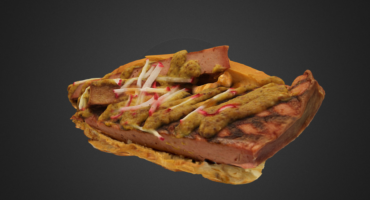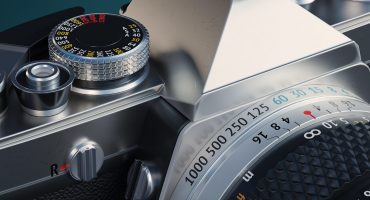In Art Spotlight, we invite Sketchfab artists to talk about one of their designs.
Hello, hello.
My name is Shabab, and I’m an aspiring game developer from Ottawa, Canada. I was introduced to 3D modeling in high school, when I got involved in the GTA modding community and started modeling low-poly cars for Vice City – fast forward a few years, and here I am, trying to make my own game and trying to not only improve my 3D modeling skills, but also to develop my art style.
Idea and Inspiration
The biggest source of inspiration for me is probably Final Fantasy 9. I absolutely love the wide range of characters they have, and I wanted to work on characters with variety. Add to that the fact that I had just recently found out what fennec foxes are, and once I got over the severe ‘kawaii’ attack, I decided to model an anthropomorphic character based on that.

Picture credit: Lopieloo, DeviantArt
Process
Naturally, the very first step was to find reference pictures. Since this is a game character, the clothing style follows the trend of the other characters (Victorian, steampunk, anything else in that general category) — I can neither confirm nor deny that I googled the words “Pride and Prejudice Darcy”.

I use Blender to do the modeling work – once I have some good reference images, I get started on the base model. For the most part, I never stick to a concrete image – I like modifying the character’s clothes, hair or other parts as I go. I prefer to keep the polycount around 1200-2000, and if it’s on the lower range of the spectrum after I’m done with the basic shape, I get to look at the model and see if I can add small details that may seem unimportant, but adds to the overall result.

With low-poly modeling, since there are limits to how much detail you can model in, a lot of the emphasis falls on the texturing. I spend the last few months trying to discover a style that looked good to me, worked with the game, and is simple enough to make changes to quickly and easily— eventually, I adopted a cel-shaded approach.
For texturing, I use Clip Studio/Manga Studio. First step is unwrapping the textures and filling them out with the base colors. My initial canvas is 2048×2048, but in the interest of performance and space, I want to be able to export it at 512×512 without losing quality – therefore, I have to prioritize areas of greater detail, such as the face and the shirt, and unwrap accordingly.

UV and flat color layer
As you can see, the head and jacket take up most of the space while boots, gloves etc. get a little less love.
If I haven’t done so already, let me emphasize my need for simplicity. I have a very hard time keeping track of 10-15 different layers, and restrict myself to only 3 layers – 1 for the base color, one for the lineart, one for the shading. Once I have the base set up, I start adding detail, such as folds, and shading them in. For this part, I generally use the same technique, whether it’s for clothing folds, or tree barks:

Since there are very few layers, and I usually only use flat colors for the base, I can change up the entire color palette or add/modify details very easily – which is extremely important for me, considering that I want to be able to make several different versions of the character.

Finally, the scene itself. Sketchfab is full of amazing dioramas, and this one in particular by Olmopotums made me want to try a small and simple island – also, I wanted to try out my stone and tree models.
I am extremely lazy, so I usually use Mixamo to do the character poses and modify them slightly to get them just right. Toss the models together, use the inverted hull method for the outline, upload to sketchfab, and voila. I love how it’s so easy to adjust the 3D settings, materials, or toss in a few post processing effects and make everything look amazing.
And here’s the final result!
Sketchfab has been a big part of my 3D learning journey over the last few weeks. This platform has allowed me to come across artists who became a major source of inspiration, such as Alice Jaunet and luyssport, and learn from their work. I also love the community, and the way the people here support other artists.
I think that’s about it – I want to thank the staff for giving me the opportunity to share my process, and for being so amazing in every way.
I hope you found this interesting or helpful! Here are some places to find me:
Thanks, Shabab! Any anthropomorphic favorites on Sketchfab? Questions? Put them in the comment box below!



